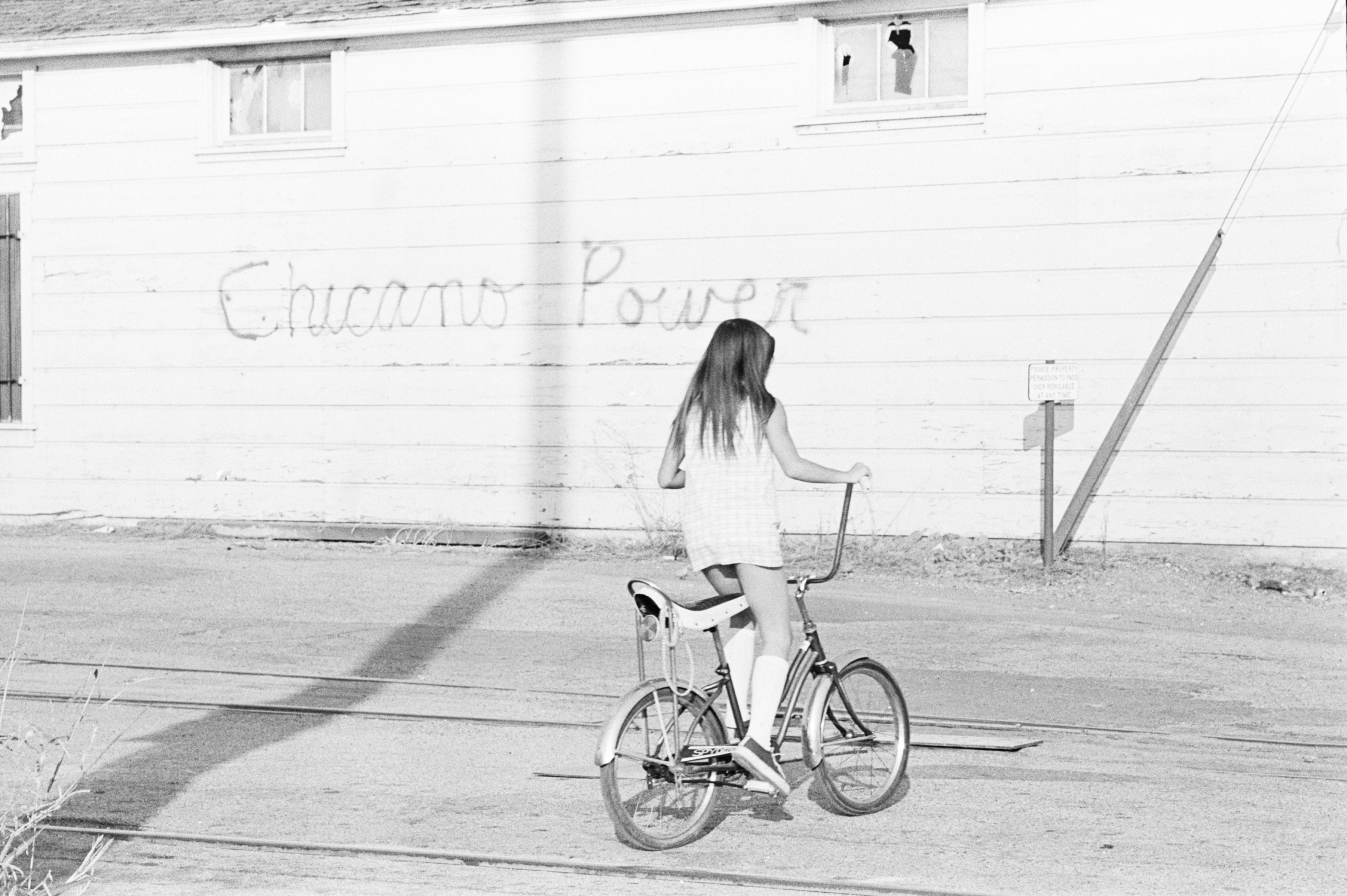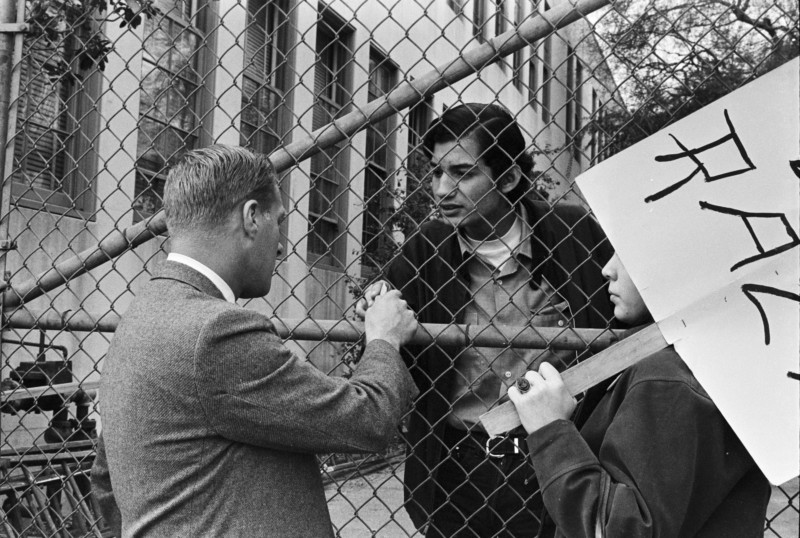Sign up for the daily CJR newsletter.
By any journalistic standard, it was a good get.
The black-and-white photograph taken by La Raza Editor in Chief Raul Ruiz captured the pivotal moment when a Los Angeles sheriff’s deputy stood on an East Los Angeles sidewalk and aimed his tear-gas launcher into the Silver Dollar Café on August 29, 1970. A tear gas missile from the launcher would fatally strike Ruben Salazar, a Los Angeles Times columnist and KMEX News Director who had become one of the few mainstream voices to tackle issues that mattered to Mexicans and Mexican Americans in a city and era when people of color were often absent from media coverage.
The investigation into Salazar’s death lagged in the same ways too many deaths of people of color get buried to this day—authorities denied wrongdoing while refusing to release investigation results for decades.
ICYMI: News organization sets out ambitious Trump plan
But while the actions of the deputy may have been in dispute (for lack of any admission of guilt, mostly), Ruiz’ photos for the now-out-of-print Chicano civil rights publication had indisputably captured a painful, course-altering moment in the city’s Chicano history. He knew the photo deserved an audience beyond what could be reached by a self-made newspaper-turned-magazine to tell the untold stories of Chicanos in East Los Angeles.
Yet, no one in the mainstream media wanted to publish it.
First, Ruiz and his team of journalists approached a young reporter for KNBC in Burbank. “His name was Tom Brokaw,” Ruiz says, dropping his voice to mimic the newsman’s gravelly on-camera delivery before letting out a laugh.
It was near midnight when Brokaw came and looked at Ruiz’s photos—the broadcaster (whose name is now emblazoned on the local bureau) said he wanted to run with it and promised to call back the next day.
Brokaw never called. When Ruiz followed up, he recalls Brokaw saying “Can’t do it. Can’t do it. They just don’t want to accept it. I’m sorry but I can’t.”
Ruiz turned to a Spanish language television station and struck out again—Channel 34 told him the photos would be too inflammatory.
It wasn’t until Ruiz decided to hold a press conference with the enlarged prints of the images that a city editor from the Los Angeles Times—Salazar’s own workplace—agreed to coverage on two conditions set by Ruiz: he didn’t want pay for the image, but demanded a credit line for the photos.
“They said ‘Oh Raul, we don’t use other people’s bylines—we’re the LA Times,’” Ruiz recalls, but in the end the newspaper conceded and printed the images crediting the Chicano journalist.
It’s an important moment in the history of both Los Angeles as a city, the American West as a region, and the civil rights story on a national level.”
While the Salazar image is now one of the best-known photographs of the era, many never-before-seen images shot by La Raza’s photographers, from 1967 to 1977, are among the 25,000 images on display in a new exhibit at the Autry Museum of the West. It offers a peek at an unvarnished catalogue of the early Mexican-American civil rights movement in Los Angeles, one corner of the national civil rights movement of the late 1960s.
“It’s an important moment in the history of both Los Angeles as a city, the American West as a region, and the civil rights story on a national level—and really fits with the Autry’s mission of telling all the stories of the people of the American West,” says Amy Scott, chief curator for the museum.
The Autry’s show is part of a network of exhibits across the city that dive into unseen and unrecognized local Latino culture, including the ways the stories of Mexican-Americans were told on the fringes of the media landscape with La Raza. The publication dug into instances of police brutality, inequality, and school segregation in East Los Angeles, and took an anti-Vietnam War stance, earning a reputation as a biased, activist publication—a distinction Ruiz acknowledges with pride.
La Raza editors decided “we were going to report the news that nobody ever reported, and if you want to call it a biased report, fine, we don’t care. The measure of our objectivity was not going to be the critics,” Ruiz says. An avid reader, Ruiz had grown up in South Los Angeles scouring the pages of American publications for a semblance of his culture and his experience as a Chicano—but the media had a blind spot.
“Why should Look Magazine or the LA Times and all that [media] exist for all these years and make a whole lot of money and never say anything about us?” Ruiz says in an interview with CJR at his Northridge, California, home. And “if they said anything about blacks it was always weird stuff, and there was hardly anything about Asians, much less Middle Eastern folks, or anybody else.”
As an activist, Ruiz admired Cesar Chavez and his advocacy for laborer’s rights through United Farm Workers—but like many Chicanos in LA, Ruiz had never worked on California farms. City-dwelling Chicanos had different problems that didn’t seem to get any attention.
La Raza dove into those issues with a pastiche of poetry, journalism, and photography. Planning for the exhibit began in 2013, Scott says, but its timeliness is undeniable.
ICYMI: News organization sets out ambitious Trump plan
If La Raza were still around, Ruiz says, it would be covering deportations and the threats to DACA recipients, and the president’s fresh-yet-dated calls to build a wall along the Mexican-American border. The racial resentment that helped elect and continues to define Donald Trump’s presidency once thrived openly in Southern California, where for the first time since Eisenhower, even conservative bastions like Orange County voted Democrat in the last presidential race.
The same Orange County where, nearly a decade before the US Supreme Court ruled that “separate is not equal” in Brown v. Board of Education, parents filed a lawsuit in 1943 because local schools were notorious for pushing Mexican and Mexican-American children into inferior schools with curriculums focused on home economics or shop. The intentions were clear and cold: to train an underclass of maids and laborers.
Though the parents won the lawsuit, legally ending segregation in California before it ended anywhere else, real advancement lagged, and high dropout rates and low literacy persisted.
Ruiz, now a professor of Chicano and Chicana Studies at Cal State Northridge, began studying high school curriculums and facilities, and noted obvious differences—like how in the richer, less diverse west side of town (in neighborhoods like Beverly Hills or Santa Monica), high schools always had sparkling swimming pools, while none of the schools in the predominantly Mexican neighborhoods in East Los Angeles did. Decades after the Orange County lawsuit that changed California law, East LA schools still offered wood shop and body shop classes rather than college-preparatory courses.
Covering education inequality was how La Raza connected to readers in East LA—attending school meetings and standing outside high schools to distribute the publication. And when thousands of students walked out of schools to protest poor conditions, in what became known as the East LA Blowouts, La Raza was there. Later, when young Chicanos marched against the Vietnam War (a day known as the Chicano Moratorium), La Raza was there.
Many of the photographs in the Autry’s exhibit are a revealing look at a lesser-known corner of the Civil Rights Movement. The archive will be accessible through a large, iPad-like display, and the museum will also host large prints of images from the Chicano Moratorium and other major events in local Latino history.
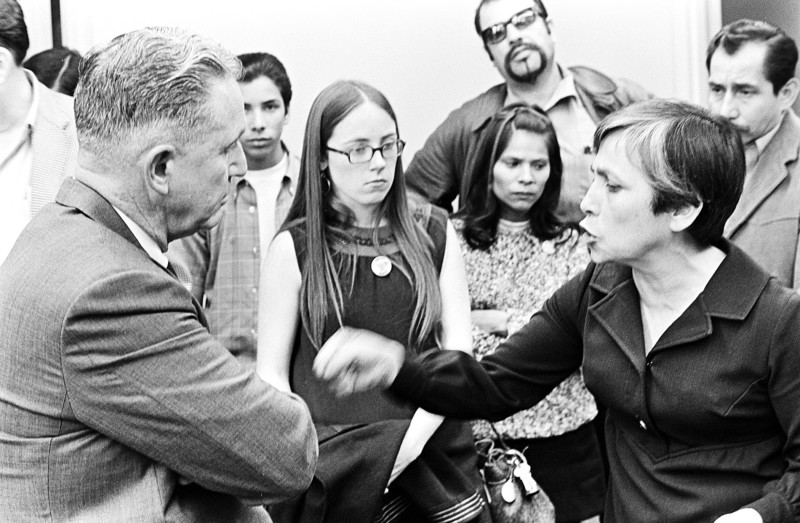
Community activists confront L.A. Board of Education administrator Ed Bonilla. Circa 1969. La Raza staff. Courtesy of the photographers and the UCLA Chicano Studies Research Center.
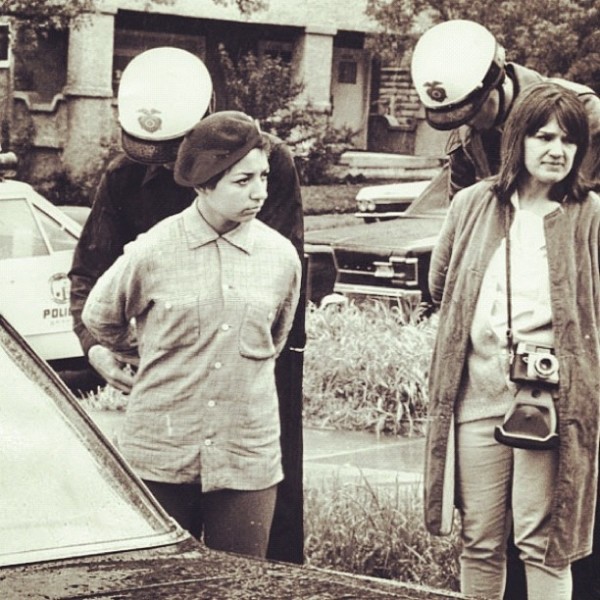
Brown Beret Margarita Sanchez , left, and Ruth Robinson, with camera, getting arrested at the Belmont High School Walkouts. March 8, 1968. Photographer unknown. Herald-Examiner Collection/Los Angeles Public Library.
***
Devra Weber, who took the above photograph, at the time was a young, social-justice obsessed graduate student at the University of California, Los Angeles, studying American labor history. She noticed an absence of Latinos and their contributions to the workforce in that history, and in the city’s newspapers.
“The Los Angeles Times was still a pretty right-wing newspaper—I mean right-wing for those days, not right-wing for now. I mean we’re talking Nazis and all sorts of crap now—but it was right-wing in that it didn’t like the Farm Worker’s Movement and would present the views of growers instead,” Weber recalls.
She began visiting East Los Angeles to study the communities and work for La Raza. As a self-described “Anglo” who was raised with Latinos, she recognized how Chavez’ movement resonated with some Americans, but urban Chicanos were regarded differently in local press.
“The urban thing—that was a little tighter for whites in the United States,” Weber said, noting that while there were anti-immigrant attitudes like the ones seen today on Fox News and alt-right outlets, “it was in some ways tamer.”
Part of that may have been because Chicanos were echoing some of the appeals of many Americans for civil rights in the late 1960s.
“Often they talk about these movements as separate, but really the Chicano movement had contact with the Native American movement, with the Civil Rights movement and Black Panthers. There are a lot of cross-movement connections that people had as individuals and as groups. And that was something that there needs to be more history written, frankly. But that was also quite exciting about what was going on in that period,” Weber said.
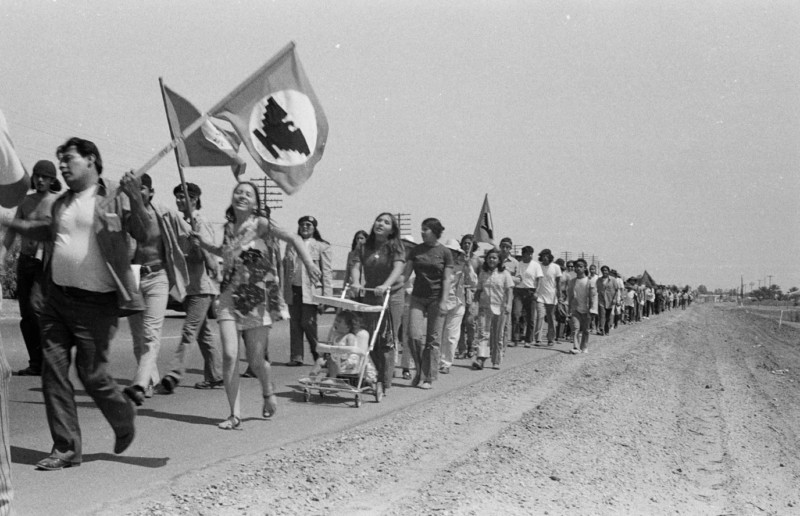
Young families join La Marcha de la Reconquista along a rural highway through Southern California. 1971. Photo by Daniel Zapata. Courtesy of the photographer and the UCLA Chicano Studies Research Center.
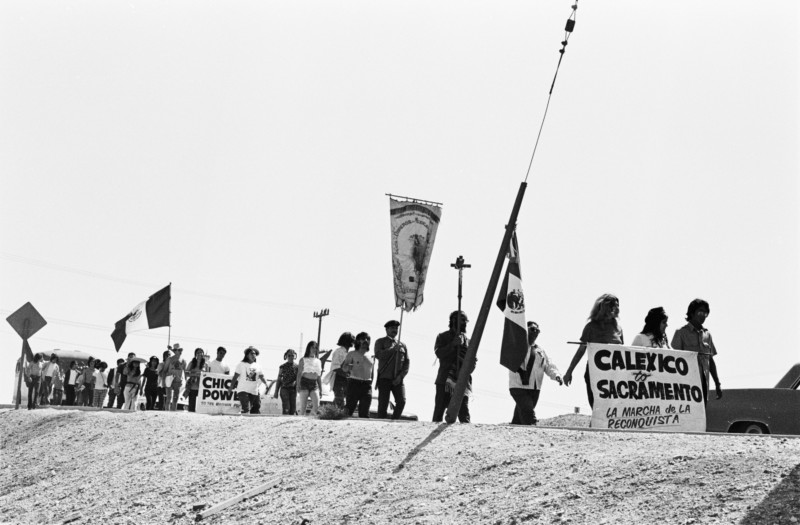
La Marcha de la Reconquista Sacramento bound. Circa 1971. Photo by Pedro Arias. Courtesy of the photographer and the UCLA Chicano Studies Research Center.
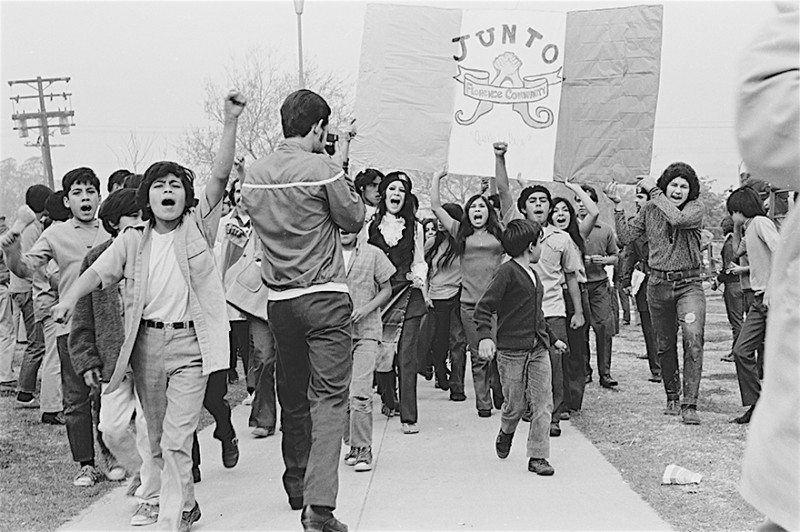
Youth from the Florencia barrio of South Central Los Angeles arrive at Belvedere Park for La Marcha Por La Justicia. January 31, 1971. Photo by Luis C. Garza. Courtesy of the photographer and the UCLA Chicano Studies Research Center .
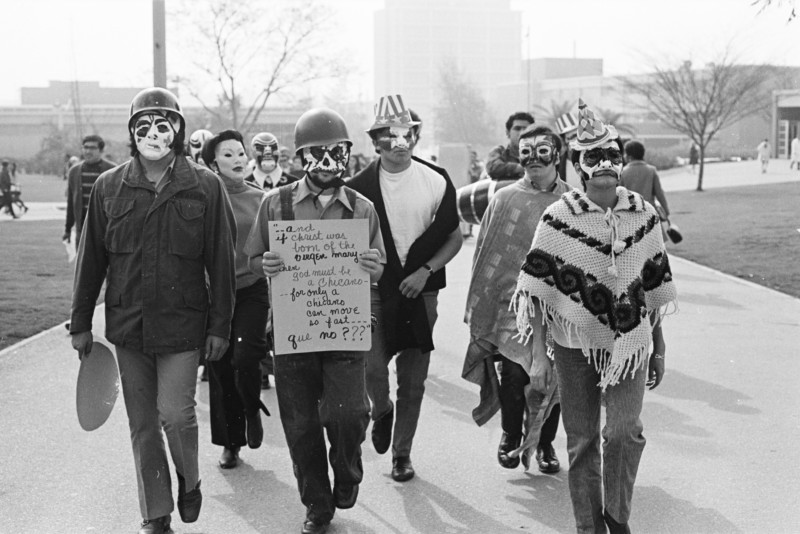
Youth from South Central LA arrive at Belvedere Park for La Marcha por la Justicia. January 31, 1971. Photo by Luis C. Garza. Courtesy of the photographer and the UCLA Chicano Studies Research Center.
***
La Raza photographer Luis Garza, who co-curated the Autry’s exhibit, recalls how anyone who covered issues that mattered to Chicanos had to be an activist in the sense that the work meant putting your body on the line, and police didn’t distinguish between protester or press in Chicano neighborhoods.
The publication wasn’t just about informing Chicanos, but it also offered a direct challenge to mainstream press and racist institutions. For La Raza, the point was to be undeniable.
“We created enough that you had to observe and you had to give recognition of what was going on in the community,” Garza says, “that you systematically have ignored and all of a sudden you’re scratching your head and wondering ‘where did this come from?’ You know let’s not be naive, it comes from hundreds of years of intentional suppression.”
In the end, in many ways, La Raza’s call for its community to rise up was that echoed one of the earliest calls to American independence: no taxation without representation.
Ruben Salazar’s death was a moment when others in media began to recognize how aggressively the voice of Chicano journalists and activists were being targeted—including a long piece exploring his death by Hunter S. Thompson for Rolling Stone.
Published in 1971, “Strange Rumblings in Aztlan” was openly critical of the local coverage, with Thompson writing:
I had seen the L.A. Times that morning, with the story of Salazar’s death, and even at a distance of 2000 miles it gave off a powerful stench. The problem was not just a gimp or a hole in the story; the whole goddamn thing was wrong. It made no sense at all. The Salazar case had a very special hook in it: Not that he was a Mexican or a Chicano, and not even [lawyer Oscar] Acosta’s angry insistence that the cops had killed him in cold blood and that nobody was going to do anything about it. These were all proper ingredients for an outrage, but from my own point of view the most ominous aspect of Oscar’s story was his charge that the police had deliberately gone out on the streets and killed a reporter who’d been giving them trouble. If this was true, it meant the ante was being upped drastically. When cops declare open season on journalists, when they feel free to declare any scene of “unlawful protest” a free fire zone, that will be a very ugly day—and not just for journalists.
True to form, Thompson’s story goes on to digress into druggy passages about the price of Seconal and acid, comparisons of local young toughs to Hells Angels, and descriptions of the local habitats of East LA’s whores and cons.
While Thompson dwelled on his interests and vices—slumming entertainingly for mainstream and mostly-white audiences—it was Chicano publications like La Raza that treated Chicanos with seriousness and had an orientation to serve the community.
To this day, Ruiz believes mainstream media tends to rely on caricatures or stereotypes to depict Chicanos. For example, DACA students are frequently profiled to express how exceptional and successful they are, but Ruiz wonders why readers still aren’t asked to have empathy for immigrant students who struggle or to care for the workers who actually make California the economic powerhouse that it is. The common Latino is still invisible to American media in that sense, and those people deserve the respect and interest of readers.
Has America ever needed a media defender more than now? Help us by joining CJR today.



